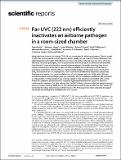Far-UVC (222 nm) efficiently inactivated an airborne pathogen in a room-sized chamber
Abstract
Many infectious diseases, including COVID-19, are transmitted by airborne pathogens. There is a need for effective environmental control measures which, ideally, are not reliant on human behaviour. One potential solution is Krypton Chloride (KrCl) excimer lamps (often referred to as Far-UVC), which can efficiently inactivate pathogens, such as coronaviruses and influenza, in air. Research demonstrates that when KrCl lamps are filtered to remove longer-wavelength ultraviolet emissions they do not induce acute reactions in the skin or eyes, nor delayed effects such as skin cancer. While there is laboratory evidence for Far-UVC efficacy, there is limited evidence in full-sized rooms. For the first time, we show that Far-UVC deployed in a room-sized chamber effectively inactivates aerosolised Staphylococcus aureus. At a room ventilation rate of 3 air-changes-per-hour (ACH), with 5 filtered-sources the steady-state pathogen load was reduced by 98.4% providing an additional 184 equivalent air changes (eACH). This reduction was achieved using Far-UVC irradiances consistent with current American Conference of Governmental Industrial Hygienists threshold limit values for skin for a continuous 8-h exposure. Our data indicate that Far-UVC is likely to be more effective against common airborne viruses, including SARS-CoV-2, than bacteria and should thus be an effective and “hands-off” technology to reduce airborne disease transmission. The findings provide room-scale data to support the design and development of effective Far-UVC systems.
Citation
Eadie , E , Hiwar , W , Fletcher , L , Tidswell , E , O'Mahoney , P , Buonanno , M , Welch , D , Adamson , C S , Brenner , D J , Noakes , C & Wood , K 2022 , ' Far-UVC (222 nm) efficiently inactivated an airborne pathogen in a room-sized chamber ' , Scientific Reports , vol. 12 , 4373 . https://doi.org/10.1038/s41598-022-08462-z
Publication
Scientific Reports
Status
Peer reviewed
ISSN
2045-2322Type
Journal article
Description
Funding: We acknowledge the financial assistance of the United Kingdom’s Department for Health and Social Care (2020/092).Collections
Items in the St Andrews Research Repository are protected by copyright, with all rights reserved, unless otherwise indicated.

